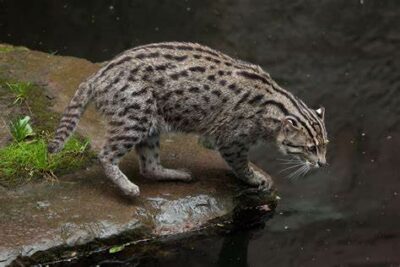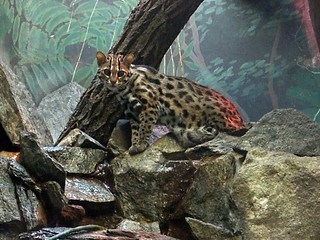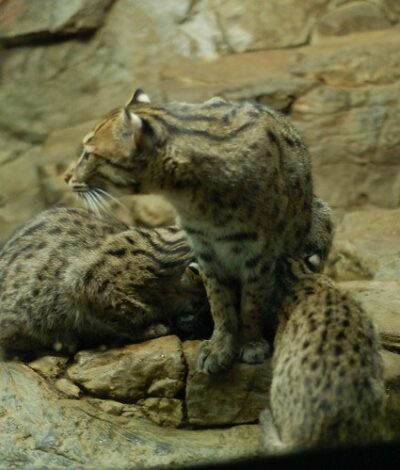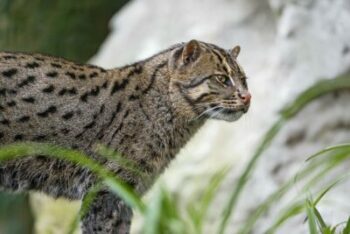Have you met any cats who love to swim? You won’t find many. Let me introduce the wild fishing cat, who absolutely loves to swim and whose primary item in his diet proves to be fresh fish. This animal can swim for long periods of time, and can dive underwater and catch supper.
Physical Description
Larger than a domestic cat, the fishing cat, who carries the Latin name of Prionailurus viverrinus, has a deep-chested body, short legs, a big, broad head and a short tail. The fur is short and coarse, in a grizzled grey color, tinged with brown.
The cat bears elongated dark brown spots which appear in longitudinal rows that cover the entire body. Six to eight dark lines run from forehead to neck; underparts appear whitish and spotted. The big, broad head has an elongated muzzle.

Equipped For Swimming
Eyes have greenish irises. Ears are short and rounded, black on the back and with prominent white spots in the middle. Short legs combine with forelimbs that have two distinct elbow bars. The relatively thick tail is less than half the head and body length, with a series of incomplete rings and a black tip.
Besides the thick, short tail, which can serve as a directional rudder, the cat’s front feet include partial webbing. The claws protrude slightly from the sheath even when retracted, giving some traction in soft underwater soil.
The fur also contributes to the cat’s fishing equipment. Their fur is layered, crucial to their adaptation to life in the water. Next to the skin lies a layer of short hair that serves as a raincoat. This fur grows in so densely that water cannot penetrate it. Thus, the animal stays warm even while fishing.
A top layer of fur features long guard hairs, giving the cat its coat pattern and a glossy sheen.
Native Habitat
The fishing cat’s typical habitats include such areas as marshy thickets, mangrove swamps, and areas along rivers and streams that are densely vegetated. The main areas where they can be found is in Southeastern Asia, Northern India and Sri Lanka.
Surprisingly, they have also turned up in tropical dry forests and even in the Indian Himalayas, at elevations of 4,900 feet. Here they live in dense vegetation near rivers and streams.
Some areas where they once lived have no reports of them in recent years. Wetland areas which they find satisfactory have become increasingly more settled, degraded, and converted, effectively destroying this cat’s habitat.

Their Typical Diet
Though the fishing cat’s primary favorite item in his diet is fish, he also enjoy feasting on other prey found in the water. These include crabs, crayfish, and frogs. To catch this water-based meal, the cat wades in shallow water and uses his paws as fishing nets, or he dives headfirst underwater to catch a meal with his teeth.
Fishing cats have also been seen eating snakes, rodents, young deer, wild pigs, and ducks. They might also go after a farmer’s chickens, dogs, goats, or calves. They even consume leftovers from another animal’s meal. Since they aren’t particular, they have several meal choices.
This cat, most likely noctournal, considers water an important part of his home territory. He can swim long distances, even under water. This unusual creature has even been observed diving underneath a swimming duck and grabbing its legs.
I’m imagining he then pulls the duck underwater and drowns it; carries it to shore, and enjoys duck for supper. Perhaps he carries it ashore and then kills it. In any case, he has a delicious meal.
Mating And Reproduction
The fishing cat’s den is constructed in dense shrubbery, reeds, hollow trees, or rocky crevices. For security, the cat finds a secluded location.

The wild fishing cats will most likely mate during January and February. Most kittens born in the wild had their birthdays in March and April. Gestation period lasts 63 to 70 days, with the female giving birth to one to four kittens. Most usual number of kittens is two.
The kittens’ eyes open by 16 days, and they will eat meat at around 53 days. Kittens are weaned between four and six months, and the adult size is attained at eight to nine months. The kitten usually leaves its mother at about 10 months of age.
Male cats may help with the care and supervision of the young, as observed in zoos where they live in captivity. However, this trait has not been verified in the wild.
Conservation Issues
Because the fishing cat depends on water for its habitat, this factor will likely cause trouble for future generations. In Southeast Asia, the principal area where these cats live, it has been estimated that about 50% of the area’s wetlands are disappearing as human population grows.
The areas become affected by pollution, over-farming and the use of chemical fertilizers in farms that drain into the wetlands. Though these fishing cats do not need to live near water, they always choose to make such an area their home. The choice, though threatened, appears to be what this cat prefers.

Data gathered assesses the cat’s numbers as having declined by over 30 percent in the last 15 years. In Thailand, researchers, working with government officials, have made this animal part of a provincial natural resources protection policy, and an extensive public awareness campaign is underway.
The fishing cat now has a conservation status of vulnerable. In an effort to protect these wild animals, the Association of Zoos and Aquariums manages a Species Survival Plan for fishing cats. If you wish to support this plan, you might contact the San Diego Zoo and offer to help.
By supporting the San Diego Zoo Wildlife Alliance, you can do your part in saving and protecting wildlife worldwide.
References I used for this post:
http://wildcatconservation.org/wild-cats/asia/fishing-cat/ animals.sandiegozoo.org/animals/fishing-cat en.wikipedia.org/wiki/Fishing_cat nationalzoo.si.edu/animals/fishing-cat


I also wrote a blog post about the fishing cat at https://mindcandymysteries.com/wp-admin/post.php?post=62&action=edit
If interested in more info about this amazing feline, you can check it out. Also some good advice to writers and others at the article’s end.
Cool — Will check it out, Elaine. Thanks!